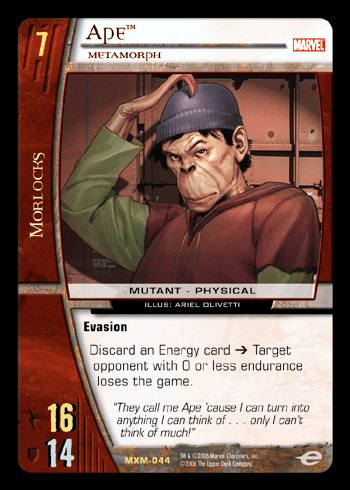
In my first spoiler article, I explained the design process that went into the creation of the Mutant traits. After determining the trait trinity of Physical, Energy, and Mental, I began to assign the traits to the characters in the initial design file. Most of the trait assignments were fairly straightforward—Professor X was Mental, Wolverine was Physical, Cyclops was Energy, and so forth.
Some characters, however, didn’t fit quite so neatly into just one category. Take Rogue, for example. Her classic powers of super strength and invulnerability stolen from Ms. Marvel put her firmly in the Physical category, but her innate ability to steal the thoughts and powers of others aligned more to the Energy trait. This led to a discussion of whether I should give these Mutants one trait or multiple traits.
The first thing I did was examine how we handled similar situations in the past with characters that had multiple power sets. Traditionally, we’ve relied on character versions to showcase different aspects of a character’s powers, team affiliations, and even costumes. Most characters couldn’t be defined by a single game effect, so we incorporated the version mechanic to allow us to create different cards of the same character.
Using this as a guideline, I could give each character a single Mutant trait with a linked power and create another copy of that character with a different version that showcased another trait.
The second and perhaps most important reason for using a single trait was that the character’s power was linked to specific categories of game effects that were defined by that trait. I could have given dual-trait Mutants two powers in their game text to represent each trait grouping of effects, or possibly a unified power that combined costs and effects from both traits. But that would have put a lot of design pressure on a sub-section of cards that was being selected mostly for thematic reasons. That could have led to certain teams getting a disproportionate number of these types of cards, and it would have certainly put a strain on Sealed Pack play.
During early development discussions, Dave Humpherys advocated the possibility of representing these types of characters by giving them a single printed trait with an effect that was stamped from a different trait category. This opened up a number of possibilities. It allowed for greater trait interaction for mono-team decks that had a mix of different Mutant traits. Also, along the same lines of the Team-Up cards that promoted dual-team decks, these two-trait characters could serve as the focal points for a dual-trait deck. From the design end, it allowed me to create hybrid game effects that pulled from each of the trait categories. Which brings us to . . .

Let’s skip over Ape’s evasion ability for now; you’ll find out more about the utility of this ability in the other Morlocks spoiler articles. There’s even a really good reason to use his evasion ability on turn 7, but I’ll leave that as a mystery for you to solve. Ape has the Physical trait, but his power is Energy stamped. So, why Physical as the default trait? Ape’s a bruiser. He typically uses his shape-changing powers to enhance his hand-to-hand combat abilities. Unlike Mystique, who uses her powers for espionage, deception, and infiltration, Ape turns his arms into giant sledgehammers and beats the crap out of anyone who wanders too far into Morlock territory.
Why is his power Energy stamped? While his shape-changing ability alters his physical body, the power it grants offers him the flexibility of dealing with situations beyond brute force. Poor Ape’s problem is that he doesn’t know how to utilize his mutant power fully. But perhaps you do.
I had created an effect similar to Ape’s back during the Superman set with The Prophecy Fulfilled. I thought it would be interesting to design an effect that interacted with the game rule of waiting to check for victory until after both players have completed what would be the final turn of the game. When I submitted the original design concept as a plot twist, it didn’t include all the play restrictions that ended up on the printed card. Development needed to ensure that the card provided enough of an interactive play axis with your opponent that you couldn’t just flip the card and win as a surprise.
Putting this effect on a character lifted some of these play restrictions, and the dual-trait stamping ensured that a player would need to put some deck construction effort into unlocking the power once Ape was in play. During Sealed Pack and Draft testing, it turned out that the effort was definitely worth the investment, and it always amused me when I read the weekly feedback emails and saw testers recording that their decks were on the “Ape Plan.”
Tomorrow's Preview: